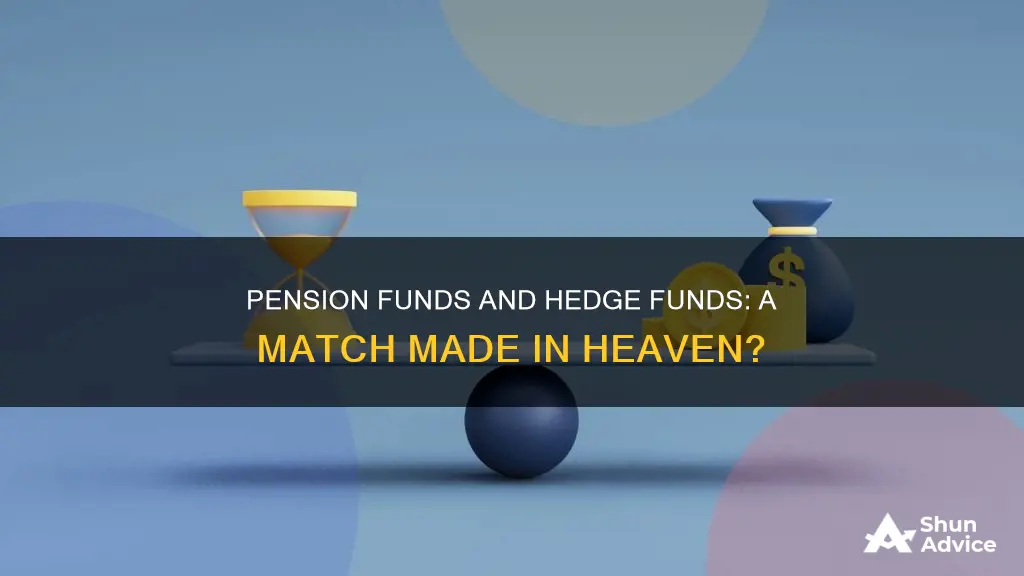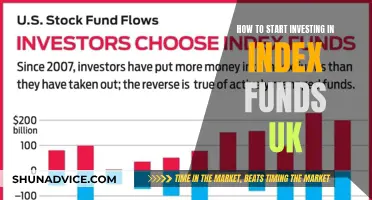
Pension funds have traditionally invested in stocks and bonds, but changing market conditions and the need to maintain high rates of return have resulted in investments in other asset classes, including hedge funds. Pension funds are one of the largest sources of capital for the private equity industry, and their allocations to hedge funds have been increasing. This is due to a number of factors, including the need to lower exposure to fixed income, the ability of hedge funds to enhance returns and provide diversification, and the fact that hedge funds can offer equity-like returns with lower correlation and better risk management. However, there is also criticism surrounding the performance and fees of hedge funds, and some pension funds have lost money by investing in them.
| Characteristics | Values |
|---|---|
| Returns | Hedge funds offer higher returns than other investment options |
| Risk | Hedge funds are considered a risky investment option |
| Diversification | Hedge funds can increase diversification and reduce downside volatility |
| Fees | Hedge funds typically charge a 2% management fee and a 20% performance fee |
| Performance | Hedge funds have underperformed compared to other investment options, such as the S&P 500 |
| Regulation | There is a lack of federal oversight and regulation for public pension funds |
What You'll Learn

Pension funds seek higher returns
Pension funds have traditionally invested in stocks and bonds, but changing market conditions and the need to maintain high enough rates of return have resulted in pension plans allowing investments in most asset classes. Pension funds are increasingly investing in a variety of asset classes, including private equity, real estate, infrastructure, and securities like gold that can hedge against inflation.
One of the main reasons pension funds invest in hedge funds is to seek higher returns. Pension funds have a fiduciary duty to their beneficiaries to maximize returns while minimizing risk. Hedge funds offer the potential for higher returns compared to traditional investments such as stocks and bonds. They employ various investment strategies, including distressed debt, specialty financing, structured credit, and relative value fixed income, to generate higher returns.
Hedge funds have the flexibility to invest in a diverse range of assets and use complex strategies that may not be available to pension funds directly. By investing in hedge funds, pension funds can access these opportunities and potentially generate higher returns for their beneficiaries.
Additionally, hedge funds can provide downside protection during bearish markets. They aim to generate positive returns even when the overall market is declining. This feature is attractive to pension funds as it helps protect the value of their investments during market downturns.
It is important to note that investing in hedge funds comes with its own set of risks and challenges. Hedge funds often charge higher fees, and their complex structures can make it difficult to evaluate and compare different investment options. Therefore, pension funds need to conduct thorough due diligence and carefully consider the potential risks and rewards before investing in hedge funds.
Overall, pension funds seek higher returns by investing in hedge funds, taking advantage of their ability to generate returns through diverse strategies and asset classes. However, it is crucial for pension funds to carefully assess and manage the associated risks to ensure they fulfill their fiduciary responsibilities.
Tips Mutual Funds: When to Invest for Maximum Returns
You may want to see also

Hedge funds offer diversification
Pension funds are increasingly investing in hedge funds to achieve diversification, reduce downside volatility, and enhance returns.
Secondly, hedge funds themselves employ a variety of investment strategies, including distressed debt, specialty financing, structured credit, and relative value fixed income. These strategies allow hedge funds to identify opportunities in diverse market conditions and reduce reliance on a single strategy or asset class.
Thirdly, hedge funds can provide a hedge against market downturns. Some hedge fund strategies have very low or negative correlations with traditional capital market benchmarks, meaning they can generate positive returns even when the broader market is declining. This feature was evident during the 2008 market sell-off, when some hedge fund strategies posted positive returns while traditional investment strategies sustained significant losses.
Additionally, hedge funds can enhance overall portfolio returns. While hedge funds may not consistently outperform the market, they aim to provide absolute positive returns with lower volatility. This combination of lower risk and steady returns can improve the risk-adjusted performance of a pension fund's portfolio.
Pension funds, particularly large institutional investors, seek diversification to balance their portfolios and manage risk effectively. By allocating a portion of their assets to hedge funds, pension funds can access a diverse range of investments and strategies that help reduce downside risk, enhance returns, and improve the overall resilience of their investment portfolios.
ETFs and Mutual Funds: Key Investment Considerations
You may want to see also

Hedge funds provide downside protection
Pension funds are increasingly allocating their capital to hedge funds. One of the reasons for this is that hedge funds provide downside protection.
Hedge funds are seen as a way to protect against downside risk. They are most likely to be used by defined benefit pension schemes rather than defined contribution schemes. Defined benefit pension schemes are pension plans that guarantee employees a set payout regardless of how investments perform. Therefore, they need to be relatively conservative in terms of risk but also achieve sufficient returns to cover those guarantees. Hedge funds can help pension funds achieve this balance.
Hedge funds can also provide diversification and enhance returns. The average hedge fund annual return is 5.9% with 6.5% volatility, which is much lower than the volatility of the S&P 500. A top-quartile hedge fund manager can provide an additional 300 basis points of return per annum, giving a pension fund a 9% return with much less volatility.
Hedge funds can also be used to fill part of a pension fund's equity bucket. They can offer an equity-like return but with lower correlation, alpha, and better risk management. This can be especially attractive in a low-interest-rate environment, where it is difficult to achieve the target return of 7-8% per year.
Additionally, some hedge fund strategies have very low or negative correlations to capital market benchmarks. This can be beneficial during a market sell-off, as correlations across asset classes and within strategies of long-only investment managers tend to rise significantly. During the market sell-off of 2008, many pension funds sustained larger-than-expected losses across their portfolios as the correlation of returns between strategies and managers increased. Hedge funds can help mitigate this risk.
Mutual Funds: Smart Investment, Diversified Portfolio, and Profits
You may want to see also

Hedge funds are a terrible investment
Most hedge funds are designed to make their managers rich. That doesn't mean they're doing anything illegal or unethical, but it does mean they're generally a terrible investment. The high fees charged by hedge funds make it difficult for investors to get ahead of the game. The typical fee structure of 2% a year plus 20% of the profits means that, to match the average return of 8% on a simple, balanced portfolio of 60% U.S. stocks and 40% Treasury bonds, a hedge fund manager would have to make about 11.5% a year gross.
Hedge funds have underperformed their benchmarks over the past decade, with several closing up shop. High fees and sluggish performance have left investors wondering if the hedge fund era is over. The harm to the hedge fund reputation has likely come from a variety of sources, including the struggle of top funds to provide exceptional returns, the shift in investor appetite towards more passively managed opportunities, and poor performance.
Hedge funds are very aggressive in the marketplace, taking strong positions and moving money very quickly. They have added a new dynamic to the market that is reflected in the enormously increased volume of stock transactions and the very greatly shortened period of time for which shares are held on average. This makes the market much more dangerous for investors who are trying to finance pensions and retirements. The growth of hedge funds has injected a much larger speculative element into the market, making it more like a casino.
Hedge funds are also very secretive and do not reveal their performance. This makes it difficult for investors to know what they are getting into and whether the fund is a good investment. The small investor is not sufficiently protected and is set up to get killed.
Mutual Funds vs Property: Where Should You Invest?
You may want to see also

Hedge funds are a source of capital for the private equity industry
Pension funds are increasingly investing in a variety of asset classes, including private equity. In fact, pension funds are one of the largest sources of capital for the private equity industry.
Private equity, in its purest form, represents managed pools of money invested in the equity of privately held companies with the intention of eventually selling the investments for substantial gains. Private equity fund managers charge high fees based on promises of above-market returns.
Pension funds have traditionally invested primarily in stocks and bonds, often using a liability-matching strategy. However, changing market conditions and the need to maintain high enough rates of return have led to pension plan rules that allow investments in most asset classes.
One reason pension funds may invest in hedge funds is to enhance returns. According to Matt Botein, Managing Director and Head of Blackrock Alternative Investors, the average hedge fund annual return of 5.9% with 6.5% volatility fares better than the S&P 500's 2.9% annualized return and 16% volatility over the past decade.
Another reason is diversification. Hedge funds can offer an equity-like return but with lower correlation, alpha, and better risk management. They can also provide downside protection, with some hedge fund strategies becoming negatively correlated during a market sell-off. This was seen in 2008 when a few hedge fund strategies posted positive returns despite the market downturn.
Pension funds are also allocating more to hedge funds due to lower interest rates and credit spreads, and the desire to lower their exposure to fixed income. With low yields on fixed-income investments, pension funds still need growth to meet their liabilities.
However, it is important to note that hedge funds have faced criticism for their high fees and underperformance compared to the market. Some pension funds have also lost money by investing in hedge funds, as seen in the case of the New York Metropolitan Transportation Authority's pension fund, which lost hundreds of millions of dollars.
Vanguard Funds: Ethical Investing and Weapons Manufacturers
You may want to see also
Frequently asked questions
Pension funds invest in hedge funds to increase diversification, reduce downside volatility and enhance returns.
Hedge funds can provide pension funds with a lower-risk investment option, as they are often less volatile than traditional asset classes such as stocks and bonds. Additionally, hedge funds can offer higher returns than fixed-income investments, which is attractive to pension funds seeking to maximise returns for retirees.
Hedge funds typically charge high fees, which can eat into the returns generated for pension funds. There is also the risk of underperformance, as hedge funds may not always beat the market or provide the expected diversification benefits.
Pension funds typically work with investment consultants and conduct annual reviews to determine their asset allocation, including the portion allocated to hedge funds. They consider factors such as expected returns, risk, and the need to diversify their portfolios.







